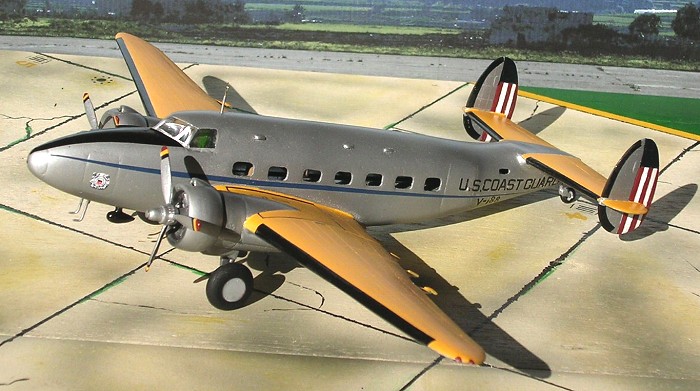
| KIT #: | ? |
| PRICE: | $? |
| DECALS: | ? |
| REVIEWER: | Carmel J Attard |
| NOTES: | Conversion |

| HISTORY |
One area in scale
aircraft modeling that has always appealed to me is that of making models
of those aircraft that were operated by the USCG over the years. This
section is very diverse and covers quite a vast range of aircraft types. To
simplify the selection I picked those aircraft types that operated over a
particular period of time and therefore divide these in two basic
categories. These are the period when the aircraft were finished in Chrome
yellow and metal finish which mainly spans a time between the early years
of the USCG until the post war era and another category consisting of the
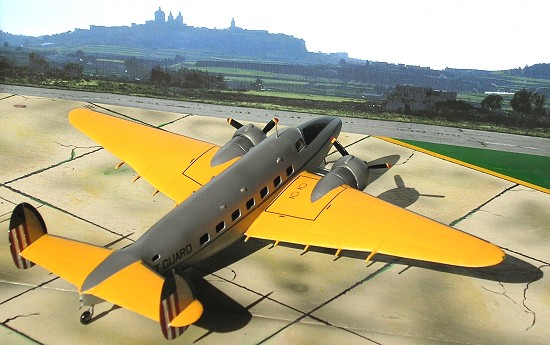 more recent period when the colour scheme was practically white and
day-glow/international orange i.e. from the mid 50s until present.
more recent period when the colour scheme was practically white and
day-glow/international orange i.e. from the mid 50s until present.
In this context I am dealing practically with the early period and several aircraft that come to my mind to name just a few are the DC3 and the B-17 USCG rescue aircraft, Catalina, Widgeon, Seagull, and Goose. I have not as yet added all of these to my ever-growing list of models that fit this section but I have already completed the Catalina, Seagull and Widgeon and next in line is the Lodestar. There is no complete kit of it on the market, and one wonders why this is so especially when one looks at its past history and when one considers that so many have been produced during and after the war era. The following is the sequence of the method I have followed to produce my Lodestar in USCG markings. This general purpose aircraft was then better known as the LOCKHEED LR50-1/4/5.
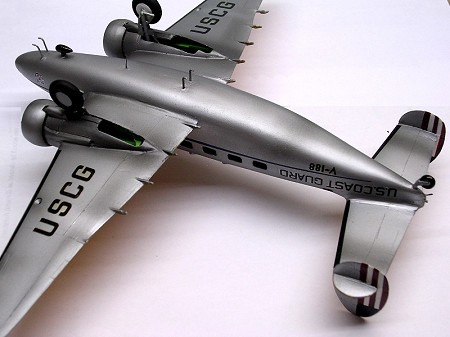 The design and
development of the Lockheed 18 Lodestar began as a result of the poor sales
achieved of the Super Electra. The prototype Lockheed 18 was developed by
converting a Super Electra, where the fuselage was lengthened by five and a
half feet, in order to accommodate 15 to 18 passengers. Some were of high
density seating of up to 26 passengers and were available with a variety of
engines made by Pratt and Whitney and Wright. The prototype flew for the
first time on 21/9/39 but it was a time when most operators were committed
to purchase the DC3 from Douglas Corporation and Lockheed failed again to
achieve worthwhile sales despite the improved economy demonstrated by the
Lodestar. The type appealed more to export customers; airline and
government agencies in Africa, Brazil, Canada, France, Netherlands, Norway,
South Africa, UK and Venezuela ordering a total of 96 aircraft. At first
there was only limited military interest but later procurement by the USAAF
in particular have raised the total to 625 aircraft it was able to fulfil
an important medium-range transport role. A small number saw post war
service with small operators. Companies in the USA like Howard Aero, and
Lear Inc converted others to executive transport.
The design and
development of the Lockheed 18 Lodestar began as a result of the poor sales
achieved of the Super Electra. The prototype Lockheed 18 was developed by
converting a Super Electra, where the fuselage was lengthened by five and a
half feet, in order to accommodate 15 to 18 passengers. Some were of high
density seating of up to 26 passengers and were available with a variety of
engines made by Pratt and Whitney and Wright. The prototype flew for the
first time on 21/9/39 but it was a time when most operators were committed
to purchase the DC3 from Douglas Corporation and Lockheed failed again to
achieve worthwhile sales despite the improved economy demonstrated by the
Lodestar. The type appealed more to export customers; airline and
government agencies in Africa, Brazil, Canada, France, Netherlands, Norway,
South Africa, UK and Venezuela ordering a total of 96 aircraft. At first
there was only limited military interest but later procurement by the USAAF
in particular have raised the total to 625 aircraft it was able to fulfil
an important medium-range transport role. A small number saw post war
service with small operators. Companies in the USA like Howard Aero, and
Lear Inc converted others to executive transport.
Interest by the US Coast Guard
 One of the
contenders of the Lockheed 18Lodestar was the United States Coast Guard,
the first of which was delivered and accepted on the 24th May
1940, for use as executive transport. This was given the designation R50-1,
Lockheed registration number 2008. The Coast Guard acquired four more R50-4
aircraft in the late 1942 with seating for 4 to 7 passengers. One of the
R50-4 was based at New York and Elizabeth City, North Carolina before the
CG Air Station was established at Washington National Airport. These were
primarily used for administration flights. One R50-4 No 05049 that was
assigned to Air Station Arlington crashed on the 24th of January
1948 in Baltimore claiming 4 casualties that were on board the aircraft.
The remaining Lodestar were phased out between 1946 and 1953 and turned
over to the Navy, the War Assets Administration and National Advisory
Committee for Aeronautics. Over 600 or so lodestars C-56s that were put
into service with the US Army Air Corps and the US Navy by various
conversions. These machines were in service through the war period 1941-45
and alongside their counterparts, C-63, together provided vital
transportation duties throughout the war.
One of the
contenders of the Lockheed 18Lodestar was the United States Coast Guard,
the first of which was delivered and accepted on the 24th May
1940, for use as executive transport. This was given the designation R50-1,
Lockheed registration number 2008. The Coast Guard acquired four more R50-4
aircraft in the late 1942 with seating for 4 to 7 passengers. One of the
R50-4 was based at New York and Elizabeth City, North Carolina before the
CG Air Station was established at Washington National Airport. These were
primarily used for administration flights. One R50-4 No 05049 that was
assigned to Air Station Arlington crashed on the 24th of January
1948 in Baltimore claiming 4 casualties that were on board the aircraft.
The remaining Lodestar were phased out between 1946 and 1953 and turned
over to the Navy, the War Assets Administration and National Advisory
Committee for Aeronautics. Over 600 or so lodestars C-56s that were put
into service with the US Army Air Corps and the US Navy by various
conversions. These machines were in service through the war period 1941-45
and alongside their counterparts, C-63, together provided vital
transportation duties throughout the war.
| THE KIT |
 Producing a Scale Model of
the Lodestar
Producing a Scale Model of
the Lodestar
Airmodel of Germany produces the Lodestar in the form of a vacform conversion kit AM-039. This comes in the form of one white plastic sheet that contains two fuselage halves along with two upper wing halves. There is also a clear vacform cockpit canopy. This kit comes at a reasonable price and is intended to borrow parts from the Airfix Lockheed Hudson Kit No 04034 in order to make a complete Lodestar C-56 scale model. The Airmodel kit also comes with a most essential data and reasonably accurate drawings, which though basic, appear to be sufficient with construction details and colour notes to produce a USAAF aircraft. These instructions in fact also suggest a C-63 which was a Hudson transport version consisting essentially of incorporating the wings provided, blanking the nose and gun positions with the rest following the Airfix instructions.
| CONSTRUCTION |
The Airmodel
wing parts carry the minimum of engraved panel lines details opposed to the
Airfix lower wing parts of the Hudson which needs to be used when making
any of the two transport versions suggested in the conversion kit
instruction sheet. So there has to be a compromise in toning down the
excessive rivet detail on the Airfix kit and adding panel lines to
 the
Airmodel vacform upper wing halves with reference to the scrap wing
view supplied. Clear study to the shape and dimensions of the wing will
show that the wings are 3mm too short towards the tips. The remedial action
is to cut chordwise the wings at a distance of 14 mm from each wing
the
Airmodel vacform upper wing halves with reference to the scrap wing
view supplied. Clear study to the shape and dimensions of the wing will
show that the wings are 3mm too short towards the tips. The remedial action
is to cut chordwise the wings at a distance of 14 mm from each wing tip and
insert a 3mm wide plastic card and shape to conform to the outline of the
wings. At this point and with the intention in mind of making the USCG R-50
I started by separating the fuselage halves from the backing sheet and
drill through and shape the 7 rectangular windows which are adequately
marked all along the fuselage sides. The fuselage halves are then sanded
down and bulkheads and cabin floors are added. These were made from the
surplus backing plastic but the forward bulkhead and cockpit floor, seat
and column comes from the Airfix kit. The interior was painted
tip and
insert a 3mm wide plastic card and shape to conform to the outline of the
wings. At this point and with the intention in mind of making the USCG R-50
I started by separating the fuselage halves from the backing sheet and
drill through and shape the 7 rectangular windows which are adequately
marked all along the fuselage sides. The fuselage halves are then sanded
down and bulkheads and cabin floors are added. These were made from the
surplus backing plastic but the forward bulkhead and cockpit floor, seat
and column comes from the Airfix kit. The interior was painted
 in
zinc chromate, and fuselage floor light grey. Seating for seven was built
inside and these painted light brown/orange colour. The fuselage halves
were then joined together and allowed to dry. Turning to the vacform
fuselage again and checking with side view will clearly show that this is
not quite deep enough and requires to be thickened at the roof area all
along the length starting from a point 3mm close to the cockpit. In order
to simplify this operation, I cut strips of 3mm thickness and 3mm wide and
stuck these next to each other, covering the upper fuselage followed by
fairing these with putty and then allowed to dry and followed by wet and
dry sanding until the final shape is acquired. It will be noticed at this
stage that the upper and lower of forward fuselage housed a variety of
aerials and antennae. It is in the interest of the modeler to make
reference to good
in
zinc chromate, and fuselage floor light grey. Seating for seven was built
inside and these painted light brown/orange colour. The fuselage halves
were then joined together and allowed to dry. Turning to the vacform
fuselage again and checking with side view will clearly show that this is
not quite deep enough and requires to be thickened at the roof area all
along the length starting from a point 3mm close to the cockpit. In order
to simplify this operation, I cut strips of 3mm thickness and 3mm wide and
stuck these next to each other, covering the upper fuselage followed by
fairing these with putty and then allowed to dry and followed by wet and
dry sanding until the final shape is acquired. It will be noticed at this
stage that the upper and lower of forward fuselage housed a variety of
aerials and antennae. It is in the interest of the modeler to make
reference to good
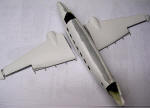 photos of the type one has in mind in the end to build
and represent.
photos of the type one has in mind in the end to build
and represent.
Turning back to
the wing parts, these were first allowed to set from the first step of
lengthening the wings towards the tips. Merging these halves with those of
the Hudson kit will soon reveal that the Hudson kits needs to be modified
to conform to the wing halves of the Airmodel kit. A strip of
plastic 2.5 X 69 mm is inserted lengthwise to each of the wing halves as
indicated in the photos. In doing so the
 correct wing shapes are now
produced. At this stage and before gluing the wing halves together I added
interior panel structural detail using stretch sprue. These followed the
exterior panel rivet detailing and panel lines. The wheel wells interior
was airbrushed in Zin
correct wing shapes are now
produced. At this stage and before gluing the wing halves together I added
interior panel structural detail using stretch sprue. These followed the
exterior panel rivet detailing and panel lines. The wheel wells interior
was airbrushed in Zin c chromate shade and allowed to dry. The wing parts
were then stuck together. A slot was cut at the fuselage sides and the
wings inserted in them. The Lodestar has now started to take shape. Again
making close examination of photos should help to add the type of antennae
carried by the Lodestar, which varied from one batch to another. The
engines were Wright Cyclone with 2X three bladed Hamilton standard hydromatic propellers. These were similar to the Hudson engines and
therefore could be used at liberty. Tail-planes and fins were also
identical and were therefore glued in proper place. Fitting the clear
vacform canopy needed little work as this conformed to the shape and
dimensions to the cockpit area. Three tiny fairings close to the wings were
added using scrap pieces of plastic to shape them up prior to fit them in
position.
c chromate shade and allowed to dry. The wing parts
were then stuck together. A slot was cut at the fuselage sides and the
wings inserted in them. The Lodestar has now started to take shape. Again
making close examination of photos should help to add the type of antennae
carried by the Lodestar, which varied from one batch to another. The
engines were Wright Cyclone with 2X three bladed Hamilton standard hydromatic propellers. These were similar to the Hudson engines and
therefore could be used at liberty. Tail-planes and fins were also
identical and were therefore glued in proper place. Fitting the clear
vacform canopy needed little work as this conformed to the shape and
dimensions to the cockpit area. Three tiny fairings close to the wings were
added using scrap pieces of plastic to shape them up prior to fit them in
position.
| COLORS & MARKINGS |
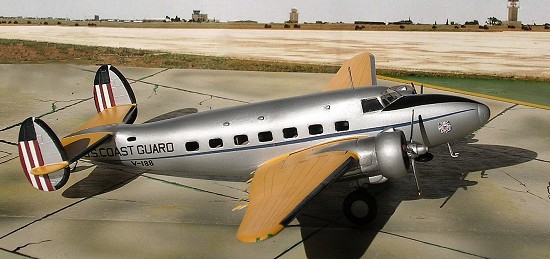 The Lodestar
model was now given a coat of Matt white to serve as a suitable undercoat
for the yellow wings and silver fuselage. Several imperfections also showed
out at this stage and these were attended to in time. The upper surface of
the mainplanes and tailplanes was sprayed in coats of chrome yellow and
allowed to get dry and applying light wet and dry smoothening in between
coats.. The wings were masked adequately and the whole model was given a
coat of Humbrol silver mixed with a little amount of satin clear varnish.
Black de icing boots were then painted on the leading edges of the wings
and tail fins
The Lodestar
model was now given a coat of Matt white to serve as a suitable undercoat
for the yellow wings and silver fuselage. Several imperfections also showed
out at this stage and these were attended to in time. The upper surface of
the mainplanes and tailplanes was sprayed in coats of chrome yellow and
allowed to get dry and applying light wet and dry smoothening in between
coats.. The wings were masked adequately and the whole model was given a
coat of Humbrol silver mixed with a little amount of satin clear varnish.
Black de icing boots were then painted on the leading edges of the wings
and tail fins
Decals of the correct size are borrowed from a USCG Superscale sheet were then added to the completed model and finally wireless aerials from fine nylon thread was carefully added to the proper places.
| CONCLUSIONS |
This was a kit that contained a certain amount of upgrading in fact this needed more work than I expected. Looking hindsight, this has offered a challenge in some respects but the end result was pleasing. In doing so another important aircraft was added to my USCG section in my scale model collection.
May 2005
Copyright ModelingMadness.com. All rights reserved. No reproduction in part or in whole without express permission from the editor.
If you would like your product reviewed fairly and fairly quickly, please contact the editor or see other details in the Note to Contributors.